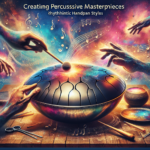In the ever-evolving world of music, there are very few instruments that can claim to have created a new wave of sound and sensation quite like the Symphonic Steel Handpan. As traditional instruments continue to hold their ground, the handpan’s unique resonance, compact design, and modern appeal have propelled it into the spotlight, distinguishing it as a revolutionary force in contemporary music.
History and Origins of the Handpan
The handpan, also known as a hang drum, originated from Switzerland in the early 2000s. Its invention is attributed to Felix Rohner and Sabina Schärer of PANArt. Intricately crafted from two hemispheres of nitrided steel, the instrument resembles an inverted steel drum and produces an enchanting resonant tone when struck by hand.
The handpan essentially combines elements of several traditional instruments. Its design is inspired by the Trinidad steelpan, the pot drum, and ghatam, among others. Over time, its distinctive sound caught the attention of musicians and percussion enthusiasts alike, blending traditional craft with a modern musical ethos.
The Symphonic Evolution
As the handpan gained popularity, musicians and craftsmen sought to expand its capabilities and sound palette. The advent of the Symphonic Steel Handpan is a testament to this evolution. Unlike its predecessors, the Symphonic Steel Handpan has been finely tuned to offer a broader range of tonalities and dynamics suited for various musical genres, including classical, jazz, and even electronic music.
The symphonic version features improved craftsmanship and materials, often incorporating higher quality steel and precise tuning techniques. These enhancements allow for a more versatile sound, bridging the gap between traditional handpans and orchestral percussion instruments.
The Anatomy of a Symphonic Steel Handpan
The core design of the Symphonic Steel Handpan remains faithful to the original handpan, with a top shell featuring multiple tone fields surrounding a central “dome,” and a bottom shell with a resonance hole. However, the differences lie in the details. The tone fields are meticulously tuned to create intricate harmonics and sustain, while the central dome and resonance hole work in harmony to amplify and project sound waves more effectively.
Some variations of the Symphonic Steel Handpan also include additional features such as built-in microphones for amplified performances and hybrid designs incorporating electronic elements for modern music applications.
Impact on Contemporary Music
The introduction of the Symphonic Steel Handpan has had a profound impact on contemporary music. It has seamlessly integrated itself into various genres, adding a unique and soothing tonal quality that is difficult to replicate with other instruments.
In orchestral settings, the Symphonic Steel Handpan has brought a new dimension to percussion sections, enriching the overall soundscape. In jazz ensembles, it complements traditional instruments with its melodic and rhythmic capabilities, while in electronic music, its otherworldly tones are often sampled and manipulated to create innovative soundscapes.
The instrument’s versatility has also made it a favorite in solo and meditative music, where its calming and ethereal sounds can take center stage.
Learning and Mastery
Learning to play the Symphonic Steel Handpan requires dedication and practice, much like any other instrument. The hand-playing technique involves striking various zones on the instrument’s surface to produce different pitches and timbres. The lack of a standardized notation system for handpan music means that much of the learning is intuitive and depends on a musician’s ability to listen and experiment.
There are now numerous resources available for aspiring handpan players, including online tutorials, workshops, and community groups. These provide valuable guidance and support, helping players to hone their skills and explore the instrument’s vast potential.
The Future of the Symphonic Steel Handpan
As the popularity of the Symphonic Steel Handpan continues to grow, so does the innovation surrounding it. Instrument makers are continuously experimenting with new materials, tunings, and designs to push the boundaries of what this instrument can achieve.
Musicians, too, are exploring novel ways to incorporate the Symphonic Steel Handpan into their compositions, finding unique applications in film scores, ambient music, and even pop songs. Its potential for cross-genre collaboration is virtually limitless.
Furthermore, technological advancements promise to bring even more exciting developments. From integrating digital effects to creating programmable handpans, the future may see the Symphonic Steel Handpan becoming an even more integral part of the global music scene.
Conclusion
The rise of the Symphonic Steel Handpan marks the beginning of a new era in percussion. Its unique sound, combined with the evolving craftsmanship, has allowed it to carve out a distinctive niche in both traditional and contemporary music. As musicians and instrument makers continue to innovate, the Symphonic Steel Handpan is poised to remain a prominent and cherished instrument for generations to come.
FAQs about the Symphonic Steel Handpan
1. What makes the Symphonic Steel Handpan different from a traditional handpan?
The Symphonic Steel Handpan offers a broader range of tonal possibilities and dynamics, finely tuned for various genres. It uses higher quality materials and improved craftsmanship to enhance sound quality and versatility.
2. How is the Symphonic Steel Handpan played?
The instrument is played by striking its surface with hands, using different zones to produce varying pitches and timbres. The technique is intuitive, relying on a musician’s ability to listen and experiment with sounds.
3. Can the Symphonic Steel Handpan be used in orchestral music?
Yes, the instrument has been successfully integrated into orchestral settings, adding a unique dimension to percussion sections and enriching overall soundscapes.
4. Is it difficult to learn the Symphonic Steel Handpan?
Learning the Symphonic Steel Handpan requires practice and dedication. There are many resources available, including tutorials, workshops, and community groups, to help learners master the instrument.
5. What are some innovative uses of the Symphonic Steel Handpan in modern music?
The instrument is being used in various modern music genres, from electronic music to film scores. Its distinctive sound is often sampled and manipulated to create innovative soundscapes, offering endless possibilities for musicians.





